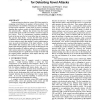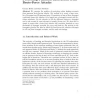86 search results - page 12 / 18 » Learning attack strategies from intrusion alerts |
KDD
2002
ACM
14 years 8 months ago
2002
ACM
Traditional intrusion detection systems (IDS) detect attacks by comparing current behavior to signatures of known attacks. One main drawback is the inability of detecting new atta...
SEC
2008
13 years 9 months ago
2008
We examine the problem of protecting online banking accounts from password brute-forcing attacks. Our method is to create a large number of honeypot userID-password pairs. Presenta...
TEC
2002
13 years 7 months ago
2002
With increased global interconnectivity, reliance on e-commerce, network services, and Internet communication, computer security has become a necessity. Organizations must protect ...
AAAI
2008
13 years 10 months ago
2008
We describe a method to improve detection of disease outbreaks in pre-diagnostic time series data. The method uses multiple forecasters and learns the linear combination to minimi...
MOBIQUITOUS
2005
IEEE
14 years 1 months ago
2005
IEEE
Caching techniques can be used to reduce bandwidth consumption and data access delay in wireless ad hoc networks. When cache is used, cache consistency issues must be addressed. T...


